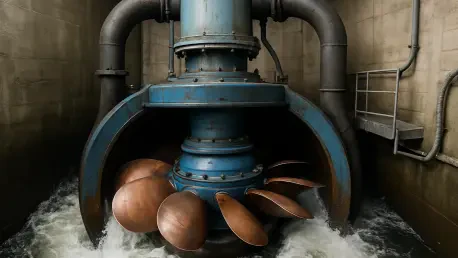In a world increasingly desperate for sustainable energy solutions to combat the devastating effects of climate change, an innovative breakthrough in hydropower has emerged as a beacon of hope for a cleaner future. Developed by an American company dedicated to advancing renewable technologies, this cutting-edge water turbine is poised to transform the way energy is harnessed from one of nature’s most abundant resources. With the global mission to achieve zero carbon emissions by 2050 driving urgency, hydropower offers a compelling alternative to weather-dependent sources like solar and wind. This particular turbine, capable of generating significant power with minimal environmental impact, taps into the vast potential of rivers, lakes, and other water bodies. Its introduction marks a pivotal moment for the renewable energy sector, especially in regions rich with water resources where such technology can thrive. As the push for cleaner energy intensifies, this development promises to play a vital role in shaping a sustainable future.
Harnessing Hydropower for a Sustainable Tomorrow
The growing demand for renewable energy has spotlighted hydropower as a reliable and consistent source, especially when compared to the intermittency of solar and wind power. Unlike those alternatives, which falter under unfavorable weather conditions, hydropower delivers steady output regardless of external factors. The latest turbine in this field stands out with its ability to produce up to 1500 W of power, enough to meet the average continuous energy needs of a typical U.S. household, which hovers around 1000 W. This impressive capacity positions it as a practical solution for residential and small-scale commercial use. What makes this technology even more remarkable is its adaptability to diverse water conditions, functioning efficiently even with low stream flows or minimal vertical drops. As the world grapples with the effects of fossil fuel dependency, such innovations highlight hydropower’s potential to lead the charge in reducing carbon footprints and fostering energy independence across varied landscapes.
Beyond raw power, the design of this turbine addresses many of the challenges faced by traditional hydroelectric systems. Its cross-flow mechanism allows water to pass transversely through the device, exiting on the opposite side while naturally clearing debris in a self-cleaning process. This feature reduces maintenance needs and enhances longevity, a critical factor for widespread adoption. Constructed from durable materials like stainless steel and heat-treated aluminum, the turbine resists corrosion and withstands harsh conditions, ensuring reliable operation over time. Additionally, it operates continuously in all weather, supports unattended power generation, and offers both AC output for efficient transmission and the option to convert to DC for battery charging. These attributes collectively make it a versatile and low-impact solution, aligning with the broader goal of transitioning to cleaner energy sources while minimizing disruption to natural ecosystems and local communities.
Overcoming Limitations of Renewable Energy Sources
While solar and wind energy have seen remarkable technological advancements over recent years, their dependency on environmental conditions remains a significant hurdle. Solar panels lose efficiency on cloudy days, and wind turbines stand idle during calm weather, creating gaps in energy production that challenge grid stability. In contrast, hydropower provides a consistent 24/7 power supply, unaffected by the whims of nature. The turbine in focus amplifies this advantage with a rated output that can peak at 2000 W under optimal conditions, surpassing many competitors in its class. Its ability to function with as little as 20 feet of vertical drop further broadens its applicability, making it suitable for areas previously deemed unfeasible for hydroelectric projects. This reliability positions hydropower as a cornerstone of renewable energy strategies, offering a dependable alternative that can support the global shift away from fossil fuels and toward sustainable systems.
Another key strength of this turbine lies in its minimal environmental and operational footprint, addressing concerns often associated with large-scale hydroelectric projects. Unlike massive dams that disrupt ecosystems and displace communities, this smaller-scale solution integrates seamlessly into existing water flows with negligible noise and a compact design. Its ease of installation and maintenance further enhances its appeal, reducing both cost and complexity for users. The turbine’s efficiency is bolstered by a design that maximizes energy extraction even under partial load, ensuring consistent performance in fluctuating conditions. As nations strive to meet ambitious carbon neutrality targets by 2050, technologies like this offer a practical pathway to scale up renewable energy adoption. By mitigating the inconsistencies of other green sources, hydropower innovations pave the way for a more resilient and sustainable energy infrastructure on a global scale.
A Step Forward in the Green Energy Movement
Reflecting on the strides made in renewable energy, the introduction of this advanced water turbine marked a significant milestone in addressing the limitations of alternative power sources. Its robust performance, coupled with a design focused on durability and efficiency, demonstrated a viable path toward reducing reliance on fossil fuels. The ability to generate substantial power with minimal environmental impact underscored the potential for hydropower to become a leading force in the clean energy landscape. Looking back, the emphasis on self-cleaning mechanisms and adaptability to low-head conditions showcased a thoughtful approach to overcoming traditional barriers in the field. This innovation stood as a testament to the ingenuity driving the sector forward, offering a glimpse into how targeted solutions could reshape energy production for generations.
As the journey toward carbon neutrality continues, the focus must shift to scaling up such technologies through strategic investments and policy support. Governments and private entities alike should prioritize integrating hydropower solutions into national grids, particularly in water-rich regions where impact can be maximized. Collaborative efforts to streamline installation processes and expand access to these turbines could accelerate adoption, ensuring that clean energy becomes a reality for more communities. Additionally, ongoing research into enhancing efficiency and reducing costs will be crucial to maintaining momentum. By building on the foundation laid by this turbine’s success, stakeholders have an opportunity to drive meaningful progress, turning the vision of a sustainable future into actionable outcomes that benefit both the planet and its inhabitants.









